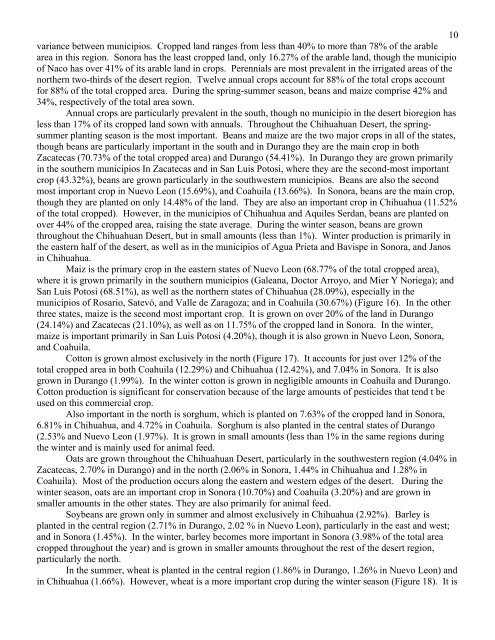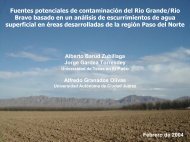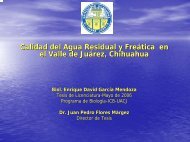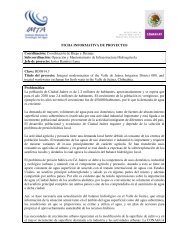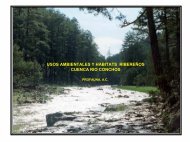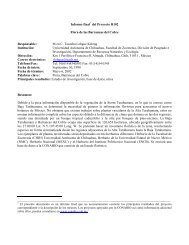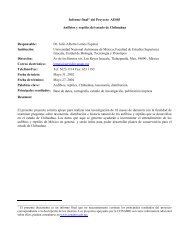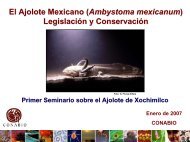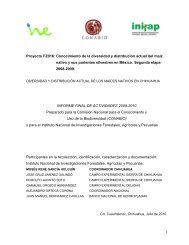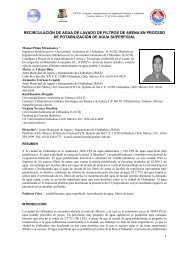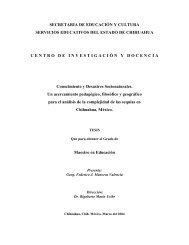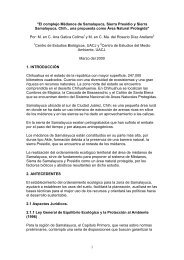land use and land tenure change in the - El Colegio de Chihuahua
land use and land tenure change in the - El Colegio de Chihuahua
land use and land tenure change in the - El Colegio de Chihuahua
You also want an ePaper? Increase the reach of your titles
YUMPU automatically turns print PDFs into web optimized ePapers that Google loves.
10variance between municipios. Cropped <strong>l<strong>and</strong></strong> ranges from less than 40% to more than 78% of <strong>the</strong> arablearea <strong>in</strong> this region. Sonora has <strong>the</strong> least cropped <strong>l<strong>and</strong></strong>, only 16.27% of <strong>the</strong> arable <strong>l<strong>and</strong></strong>, though <strong>the</strong> municipioof Naco has over 41% of its arable <strong>l<strong>and</strong></strong> <strong>in</strong> crops. Perennials are most prevalent <strong>in</strong> <strong>the</strong> irrigated areas of <strong>the</strong>nor<strong>the</strong>rn two-thirds of <strong>the</strong> <strong>de</strong>sert region. Twelve annual crops account for 88% of <strong>the</strong> total crops accountfor 88% of <strong>the</strong> total cropped area. Dur<strong>in</strong>g <strong>the</strong> spr<strong>in</strong>g-summer season, beans <strong>and</strong> maize comprise 42% <strong>and</strong>34%, respectively of <strong>the</strong> total area sown.Annual crops are particularly prevalent <strong>in</strong> <strong>the</strong> south, though no municipio <strong>in</strong> <strong>the</strong> <strong>de</strong>sert bioregion hasless than 17% of its cropped <strong>l<strong>and</strong></strong> sown with annuals. Throughout <strong>the</strong> <strong>Chihuahua</strong>n Desert, <strong>the</strong> spr<strong>in</strong>gsummerplant<strong>in</strong>g season is <strong>the</strong> most important. Beans <strong>and</strong> maize are <strong>the</strong> two major crops <strong>in</strong> all of <strong>the</strong> states,though beans are particularly important <strong>in</strong> <strong>the</strong> south <strong>and</strong> <strong>in</strong> Durango <strong>the</strong>y are <strong>the</strong> ma<strong>in</strong> crop <strong>in</strong> bothZacatecas (70.73% of <strong>the</strong> total cropped area) <strong>and</strong> Durango (54.41%). In Durango <strong>the</strong>y are grown primarily<strong>in</strong> <strong>the</strong> sou<strong>the</strong>rn municipios In Zacatecas <strong>and</strong> <strong>in</strong> San Luis Potosi, where <strong>the</strong>y are <strong>the</strong> second-most importantcrop (43.32%), beans are grown particularly <strong>in</strong> <strong>the</strong> southwestern municipios. Beans are also <strong>the</strong> secondmost important crop <strong>in</strong> Nuevo Leon (15.69%), <strong>and</strong> Coahuila (13.66%). In Sonora, beans are <strong>the</strong> ma<strong>in</strong> crop,though <strong>the</strong>y are planted on only 14.48% of <strong>the</strong> <strong>l<strong>and</strong></strong>. They are also an important crop <strong>in</strong> <strong>Chihuahua</strong> (11.52%of <strong>the</strong> total cropped). However, <strong>in</strong> <strong>the</strong> municipios of <strong>Chihuahua</strong> <strong>and</strong> Aquiles Serdan, beans are planted onover 44% of <strong>the</strong> cropped area, rais<strong>in</strong>g <strong>the</strong> state average. Dur<strong>in</strong>g <strong>the</strong> w<strong>in</strong>ter season, beans are grownthroughout <strong>the</strong> <strong>Chihuahua</strong>n Desert, but <strong>in</strong> small amounts (less than 1%). W<strong>in</strong>ter production is primarily <strong>in</strong><strong>the</strong> eastern half of <strong>the</strong> <strong>de</strong>sert, as well as <strong>in</strong> <strong>the</strong> municipios of Agua Prieta <strong>and</strong> Bavispe <strong>in</strong> Sonora, <strong>and</strong> Janos<strong>in</strong> <strong>Chihuahua</strong>.Maiz is <strong>the</strong> primary crop <strong>in</strong> <strong>the</strong> eastern states of Nuevo Leon (68.77% of <strong>the</strong> total cropped area),where it is grown primarily <strong>in</strong> <strong>the</strong> sou<strong>the</strong>rn municipios (Galeana, Doctor Arroyo, <strong>and</strong> Mier Y Noriega); <strong>and</strong>San Luis Potosi (68.51%), as well as <strong>the</strong> nor<strong>the</strong>rn states of <strong>Chihuahua</strong> (28.09%), especially <strong>in</strong> <strong>the</strong>municipios of Rosario, Satevó, <strong>and</strong> Valle <strong>de</strong> Zaragoza; <strong>and</strong> <strong>in</strong> Coahuila (30.67%) (Figure 16). In <strong>the</strong> o<strong>the</strong>rthree states, maize is <strong>the</strong> second most important crop. It is grown on over 20% of <strong>the</strong> <strong>l<strong>and</strong></strong> <strong>in</strong> Durango(24.14%) <strong>and</strong> Zacatecas (21.10%), as well as on 11.75% of <strong>the</strong> cropped <strong>l<strong>and</strong></strong> <strong>in</strong> Sonora. In <strong>the</strong> w<strong>in</strong>ter,maize is important primarily <strong>in</strong> San Luis Potosi (4.20%), though it is also grown <strong>in</strong> Nuevo Leon, Sonora,<strong>and</strong> Coahuila.Cotton is grown almost exclusively <strong>in</strong> <strong>the</strong> north (Figure 17). It accounts for just over 12% of <strong>the</strong>total cropped area <strong>in</strong> both Coahuila (12.29%) <strong>and</strong> <strong>Chihuahua</strong> (12.42%), <strong>and</strong> 7.04% <strong>in</strong> Sonora. It is alsogrown <strong>in</strong> Durango (1.99%). In <strong>the</strong> w<strong>in</strong>ter cotton is grown <strong>in</strong> negligible amounts <strong>in</strong> Coahuila <strong>and</strong> Durango.Cotton production is significant for conservation beca<strong>use</strong> of <strong>the</strong> large amounts of pestici<strong>de</strong>s that tend t be<strong>use</strong>d on this commercial crop.Also important <strong>in</strong> <strong>the</strong> north is sorghum, which is planted on 7.63% of <strong>the</strong> cropped <strong>l<strong>and</strong></strong> <strong>in</strong> Sonora,6.81% <strong>in</strong> <strong>Chihuahua</strong>, <strong>and</strong> 4.72% <strong>in</strong> Coahuila. Sorghum is also planted <strong>in</strong> <strong>the</strong> central states of Durango(2.53% <strong>and</strong> Nuevo Leon (1.97%). It is grown <strong>in</strong> small amounts (less than 1% <strong>in</strong> <strong>the</strong> same regions dur<strong>in</strong>g<strong>the</strong> w<strong>in</strong>ter <strong>and</strong> is ma<strong>in</strong>ly <strong>use</strong>d for animal feed.Oats are grown throughout <strong>the</strong> <strong>Chihuahua</strong>n Desert, particularly <strong>in</strong> <strong>the</strong> southwestern region (4.04% <strong>in</strong>Zacatecas, 2.70% <strong>in</strong> Durango) <strong>and</strong> <strong>in</strong> <strong>the</strong> north (2.06% <strong>in</strong> Sonora, 1.44% <strong>in</strong> <strong>Chihuahua</strong> <strong>and</strong> 1.28% <strong>in</strong>Coahuila). Most of <strong>the</strong> production occurs along <strong>the</strong> eastern <strong>and</strong> western edges of <strong>the</strong> <strong>de</strong>sert. Dur<strong>in</strong>g <strong>the</strong>w<strong>in</strong>ter season, oats are an important crop <strong>in</strong> Sonora (10.70%) <strong>and</strong> Coahuila (3.20%) <strong>and</strong> are grown <strong>in</strong>smaller amounts <strong>in</strong> <strong>the</strong> o<strong>the</strong>r states. They are also primarily for animal feed.Soybeans are grown only <strong>in</strong> summer <strong>and</strong> almost exclusively <strong>in</strong> <strong>Chihuahua</strong> (2.92%). Barley isplanted <strong>in</strong> <strong>the</strong> central region (2.71% <strong>in</strong> Durango, 2.02 % <strong>in</strong> Nuevo Leon), particularly <strong>in</strong> <strong>the</strong> east <strong>and</strong> west;<strong>and</strong> <strong>in</strong> Sonora (1.45%). In <strong>the</strong> w<strong>in</strong>ter, barley becomes more important <strong>in</strong> Sonora (3.98% of <strong>the</strong> total areacropped throughout <strong>the</strong> year) <strong>and</strong> is grown <strong>in</strong> smaller amounts throughout <strong>the</strong> rest of <strong>the</strong> <strong>de</strong>sert region,particularly <strong>the</strong> north.In <strong>the</strong> summer, wheat is planted <strong>in</strong> <strong>the</strong> central region (1.86% <strong>in</strong> Durango, 1.26% <strong>in</strong> Nuevo Leon) <strong>and</strong><strong>in</strong> <strong>Chihuahua</strong> (1.66%). However, wheat is a more important crop dur<strong>in</strong>g <strong>the</strong> w<strong>in</strong>ter season (Figure 18). It is


